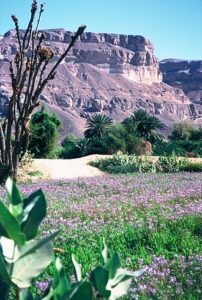 Like most explorers, let us presume, Theodore Bent was protective and proud of his achievements – setting difficult targets, being first, or among the very first. And in his list of hard things done, right up there is his first foray of 1894 (January-March) deep into Southern Arabia, the Yemeni interior – the breath-taking Wadi Hadhramaut – unforgiving, challenging, alien, romantic.
Like most explorers, let us presume, Theodore Bent was protective and proud of his achievements – setting difficult targets, being first, or among the very first. And in his list of hard things done, right up there is his first foray of 1894 (January-March) deep into Southern Arabia, the Yemeni interior – the breath-taking Wadi Hadhramaut – unforgiving, challenging, alien, romantic.
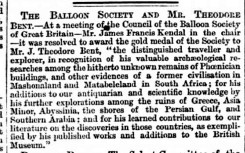
Some background. By 1894 Bent stood out in a crowd; a respected and spur-earned explorer – FSA, FRGS, and winner of the Balloon Society’s prestigious gold medal. Most readers associate the Bents with the Eastern Mediterranean and their researches there, and these readers get no further than the Cyclades or Dodecanese. Yet this region represents only a third of their travels, and we must not overlook them, too, in the dusts and deserts of Africa and Arabia.
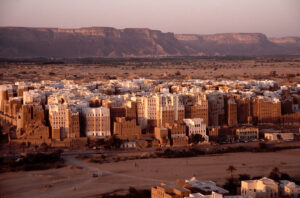
For their early 1893 season, Theodore and Mabel headed for the north-east of the Horn of Africa, looking for possible clues in the civilisations of early Ethiopians that might link Mashonaland’s ruins (modern Zimbabwe) of ‘Great Zimbabwe’, the couple’s quest in 1891, to the very old trade routes that led into Egypt, to the west, and to Southern Arabia to the east. Clues would include early ‘Arabian’ (Sabaean primarily) inscriptions from ancient Aksum (its royal family claiming descent from Menelik, the son of the Queen of Sheba, who had the Ark of the Covenant from Jerusalem hidden in his capital). And it was, in a way, the Queen of Sheba who beguiled Theodore for the last five years of his short life.
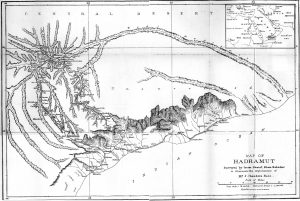
Back in London from the Red Sea by the early summer of 1893, Theodore lectured widely, announcing that he had now evidence from Zimbabwe and Ethiopia of the remains of a Sabaean ‘civilisation’ from the vast peninsula of Southern Arabia, out-posting down the east coast of Africa. Bent hoped soon to be able to “reconstruct the history of a once mighty commercial race, which was contemporaneous with the best days of Egypt, Greece and Rome, and which provided the ancient world with most of its most valued luxuries.” Included with these luxuries were the exotic resins of frankincense and myrrh; it was the search for them, and the many routes they were transported along, that were the themes of Theodore’s articles and lectures in the summer of 1893.
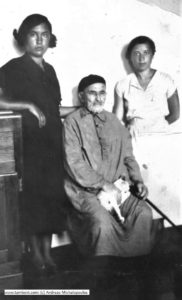 By summer’s end, Theodore was in a position to begin preparing a large expedition to Southern Arabia and the Wadi Hadhramaut (Hadramawt or Hadramout) itself the following season, a party that would include his wife Mabel, of course, as well as his Sancho Panza-like assistant, the Anafiot Matthew Simos, a young botanist from Kew, William Lunt (1871-1904), “Baÿoumi, known to us as Mahmoud, an Arab, who came on at Alexandria. He is provided by the Madras Museum as our Zoologist”, and the highly accomplished Indian surveyor/cartographer, Imam Sharif, whose later map of the region is a delight to this day.
By summer’s end, Theodore was in a position to begin preparing a large expedition to Southern Arabia and the Wadi Hadhramaut (Hadramawt or Hadramout) itself the following season, a party that would include his wife Mabel, of course, as well as his Sancho Panza-like assistant, the Anafiot Matthew Simos, a young botanist from Kew, William Lunt (1871-1904), “Baÿoumi, known to us as Mahmoud, an Arab, who came on at Alexandria. He is provided by the Madras Museum as our Zoologist”, and the highly accomplished Indian surveyor/cartographer, Imam Sharif, whose later map of the region is a delight to this day.
A few weeks before setting off (via Marseilles, Suez and Aden), the Bents had sent out a press release (they were unabashed self-publicists): “Mr. Theodore Bent has almost completed his arrangements for his journey to the Hadhramaut country, in Southern Arabia, which he proposes to explore this winter. He starts about the end of next month for Aden, and will then proceed along the coast to Makulla, which is to be his starting point into the interior. The extensive region of Hadhramaut is but little known, and Mr. Bent proposes to make as thorough a survey as possible of the country. He, himself, will pay particular attention to the archæology of the districts, and he will probably be accompanied by a native Indian surveyor, as well as by specialists in botany and zoology. Mr. Bent, who will, as on all his journeys, be accompanied by Mrs. Bent, hopes to be back in England by May or June of next year.” (The Manchester Guardian, 22 October 1893.)
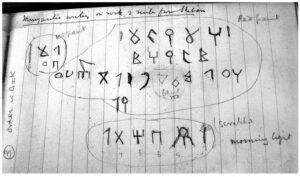
The Iron Age (1100–650 BC) of Southern Arabia, primarily of interest to Theodore, is marked by a network of competing city-states and pre-Islamic kingdoms (Sabaean, Awsanian, Minaean, Qatabanian, Hadramautian and Himyarite). Distinguished by the appearance of early writing, the Sabaeans rose to prominence, based at Marib by the 5th century BC, their influence extending throughout the western Hadhramaut. Notwithstanding a brief annexation by the kingdom of Aksum (in modern Ethiopia) around 500 BC, keen for more control of the area’s rich natural resources, Shabwa remained a centre of culture and learning until its eventual decline around the 5th century AD and the ascendancy of the highland-Yemen Himyarites, followed by periods of Sassanian (eastern) and Roman/Byzantine (western) power, before the rise of Islam (c. 650 AD).
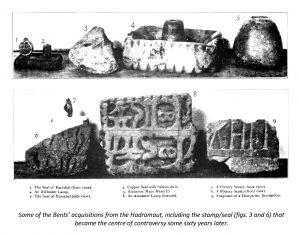 For Theodore and his contemporaries the Hadhramaut was represented by the eponymous wadi/valley system in today’s eastern Yemen. As for its physical geography, the region extends over 600 km from west to east, consisting of a narrow, arid coastal plain, a broad plateau averaging 1400 m in height, a bewildering maze of deeply sunken wadis, and a final escarpment that abuts the great desert to the north. These uncompromising, awe-inspiring landscapes have facilitated movements of people over the millennia, and the objective of Theodore’s mission in 1894 was to penetrate the said Wadi Hadhramaut (approaching from the south, via Al-Makulla on the coast) and, ultimately descending south–east, to reach the Indian Ocean again at Sayhut.
For Theodore and his contemporaries the Hadhramaut was represented by the eponymous wadi/valley system in today’s eastern Yemen. As for its physical geography, the region extends over 600 km from west to east, consisting of a narrow, arid coastal plain, a broad plateau averaging 1400 m in height, a bewildering maze of deeply sunken wadis, and a final escarpment that abuts the great desert to the north. These uncompromising, awe-inspiring landscapes have facilitated movements of people over the millennia, and the objective of Theodore’s mission in 1894 was to penetrate the said Wadi Hadhramaut (approaching from the south, via Al-Makulla on the coast) and, ultimately descending south–east, to reach the Indian Ocean again at Sayhut.

Although ‘Europeans’ had been sailing and exploiting the coastlines of Arabia for hundreds of years, Britain’s need in the early 19th century to secure its sea-lanes to India and the Persian Gulf precipitated a brilliant campaign of coastal surveys that effectively drifted from Aden to Muscat. The captains and officers of British vessels wrote and eventually reported back to London on their findings – strategic, botanic, folkloric.
Dependence on their ships meant that these men (and of the women, Mabel Bent, not Lady Anne Blunt, not Freya Stark, not Kate Humble even, was, we think, the first willing Western woman to do so – how many hundreds have unwillingly seen the moon and stars there?) were unable to venture far inland, and it was not until as late as 1843 that the borders of the Hadhramaut interior were reached by the German Baron Adolf von Wrede in 1843. As for the great mud-brick cities of the main Wadi Hadhramaut itself, they were not visited until 50 years later, and by another German, Leo Hirsch, who, by great coincidence, was covering some of the same trails as the Bents, and just a few months ahead of them in 1894: therefore ‘to these two parties the credit of the discovery of the Wadi Hadhramaut itself belongs.’ (generally for this background, see Hogarth 1905: 206-225)
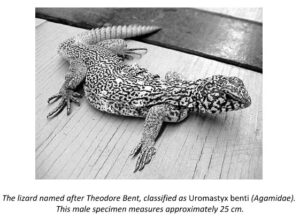 Some achievement – unarguably the area is more dangerous now than at the time of the Bents’ visits (they were to make three concerted attempts). Today the region is fatal for tourists; there are pirates off Aden and in January 2008 two Belgian and two Yemeni nationals were shot dead, with four other Belgians seriously injured, in an incident in the Hadhramaut. As a result, the UK government issued a warning that would have stopped the Bents in their tracks (well, perhaps): ‘We advise against all but essential travel to the Governorates of Sa’dah, Ma’rib and Hadhramaut due to the threat of terrorism and tribal violence. You should take all the necessary steps to protect your safety, and you should make sure that you have confidence in your individual security arrangements. You should maintain a high level of vigilance in public places and exercise caution, particularly outside urban areas.’ (N.B. the lizards are harmless.)
Some achievement – unarguably the area is more dangerous now than at the time of the Bents’ visits (they were to make three concerted attempts). Today the region is fatal for tourists; there are pirates off Aden and in January 2008 two Belgian and two Yemeni nationals were shot dead, with four other Belgians seriously injured, in an incident in the Hadhramaut. As a result, the UK government issued a warning that would have stopped the Bents in their tracks (well, perhaps): ‘We advise against all but essential travel to the Governorates of Sa’dah, Ma’rib and Hadhramaut due to the threat of terrorism and tribal violence. You should take all the necessary steps to protect your safety, and you should make sure that you have confidence in your individual security arrangements. You should maintain a high level of vigilance in public places and exercise caution, particularly outside urban areas.’ (N.B. the lizards are harmless.)
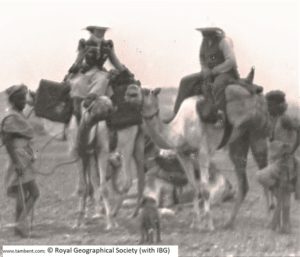
Mabel often boasted later of an incident on this 1894 adventure when they were “Besieged by crowds calling us pigs and dogs and gavers, and one day they said ‘come down off your camels and we’ll cut your throats’. I drew [our] interpreter aside and said ‘Tell them when they ask you not to be afraid, for… if wanted, our Queen would have taken [the country] long before we were born, and if she wanted it now she would not send 8 subjects unarmed for the business…’” (The Travel Chronicles of Mabel Bent, Vol. 3, 2010: 346).
Understandably, the Bents looked on their adventures in the Hadhramaut with considerable pride, even though they never completely realized their objective to traverse the wadi west–east, and arrive, their considerable gear and large party on camels, mules and horse, trekking south, weeks later back at the sea, not so far from the borders of modern Oman.
Imagine then, disembarking from the fine P&O steamer Kaisar i Hind at Marseilles in the third week of April 1894, resting and waiting there a few days for a train to Calais and the Dover ferry for home, his surprise, nay outrage, on reading in a copy of The Graphic, waiting for him poste restante, a flippant account by three boys in an article that could have come straight from a rag mag (by the tone of some of its paragraphs), boasting that this trio of pranksters had got to the Hadhramaut first! The piece is redeemed only by some astonishingly fine sketches done by one of them…
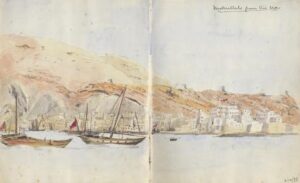
These three braggarts were Frederick Noel Paton (1861-1914), later a British explorer and Anglo-Indian official, and the two Molesworth boys: Guy Layard Nassau (1865-1920), who became a successful civil engineer, and Henry Bridges, subsequently a naval officer and engineer. It was the latter who drew the lovely coloured sketches of the trip in his diary, now in the Royal Geographical society and available via, and ©, gettyimages (no infringement here intended).
Here is a cut-and-paste flavour of the boys’ breathless account in The Graphic; Theodore’s outrage is palpable: “The territory traversed by the Bent expedition, recently noticed in the English and other journals, is more circumscribed than Mr. Bent probably supposed before starting… There is nothing but rock and dust, soda and sulphur, fever and sunstroke. If an enterprising Bedouin, or even Mr. Bent succeeds in finding in that country something that is useful or important, he will deserve great credit… These facts may, perhaps, be found of interest; and they may be relied upon as accurate, seeing that the writer [Paton], with two other Englishmen [the Molesworth boys], has just returned from traversing the same ground which Mr. Bent is now exploring… Our friend [M. Jacques de Zogab], who had taken the steamer back to Aden on the 3rd [December 1893], gladly offered Mr. Bent and his companions a passage on the return voyage to Hadramaut. He landed them at Mokullah on the 17th, and picked us up at Shehr on the 18th, so that we had no opportunity of putting our experience at Mr. Bent’s disposal [!]. It was not till we then received accumulated letters that we learned from enclosed journalistic reports of Mr. Bent’s communication about his expedition, that our position as pioneers of that region would obtain imprimatur of such authority [!!]. We may mention that in a cairn on the summit of Chub-thub will be found a scroll bearing the signatures of H.B. Molesworth and Guy Molesworth; while in the Palace at Ghraïl is a mural picture representing our State entry into that city, and signed Frederick Noel Paton… The writer of the above points out that he traversed the ground which Mr. Bent proposed to explore, and it is interesting to note that, according to the latest intelligence received from Aden, Mr. Theodore Bent and his party on the 3rd inst. reached Shehr (or Sheher), on the coast to the north-east of Mokullah, the point from which the expedition commenced its march into the interior. Mr. and Mrs. Bent and the other members of the party were in good health…” (The Exploration of Southern Arabia – A Journey in the Hadramaut, by F. Noel Paton; The Graphic, 31 March 1894, pp. 370 ff.). Outrageous stuff!
Apoplectic probably, Theodore demanded a right of reply immediately from their hotel (the “Hôtel du Louvre and de la Paix (otherwise pay)” – and got one; it is reproduced in full from The Graphic of 5 May 1894, page 518: “The Exploration of the Hadramaut – Mr. Theodore Bent, writing from Marseilles with reference to an article in The Graphic of March 31, says:- ‘I should be much obliged if you will kindly correct certain statements therein contained concerning my expedition to the Hadramaut. Your correspondent, Mr. Noel Paton, did not traverse the ground which we proposed to explore,’ only going twelve miles inland, whereas the Hadramaut does not begin until 120 miles inland, and the coast line has nothing to do with that district. Our exploration of the Hadramaut in no way has to do with the part of the country traversed by Mr. Noel Paton.’” So there.
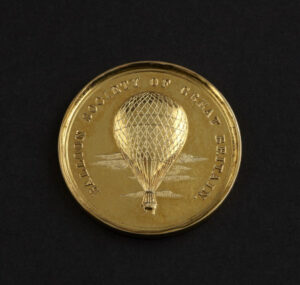
Your travel guides on this journey are: (1) Southern Arabia by Mabel and Theodore Bent (1900, London); (2) The Travel Chronicles of Mrs J Theodore Bent, Vol. 3, Arabia (2010, Oxford, and from which several quotes appear above); and (3) The penetration of Arabia: a record of the development of western knowledge concerning the Arabian peninsula (1905, London), by D.G. Hogarth, Arabist, agent, archaeologist, and very grudging indeed admirer of J. Theodore Bent, who had pipped him to the post at Olba, western Turkey, a quarter of a century before.
 Leave a comment or contact us about this article
Leave a comment or contact us about this article
